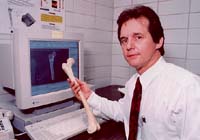 Robert Latour, bioengineering professor, Clemson
University, holds a human femur as seen against the computerized femur.
Robert Latour, bioengineering professor, Clemson
University, holds a human femur as seen against the computerized femur.Computer models to analyze hip replacement
 Robert Latour, bioengineering professor, Clemson
University, holds a human femur as seen against the computerized femur.
Robert Latour, bioengineering professor, Clemson
University, holds a human femur as seen against the computerized femur.
Thousands of hip-replacement patients may benefit from a collaborative research effort by Clemson University, the Greenville Hospital System, MUSC and Veterans Affairs.
At the heart of the research is a complex computer modeling program which the research group developed to simulate and analyze the intricacies of load transfer within the body's musculoskeletal system.
In short, the miracle behind human locomotion. "This program will help us understand the full range of mechanical problems involved with hip joint replacement," said Robert Latour, the bioengineering professor at Clemson University who originated the project.
"By developing very realistic computer models that simulate how the stress fields in the bone are altered following hip joint replacement, we'll be able to gain a much better understanding of how implants should be designed and manufactured to obtain a better performing, longer lasting and more easily replaceable artificial hip joint."
The implant would mainly benefit arthritis sufferers, who now account for most of the estimated 250,000 hip joint replacement surgeries performed yearly in the United States.
The improved version could be on the market within five to 10 years, Latour said.
The new-generation implants will utilize leading-edge ceramics, metal alloys and fiber-reinforced polymer construction. One key advantage they will have over current metal implants is that they can be engineered so that their day-to-day performance will maintain more normal stresses within the surrounding bone. That, in turn, will help prevent the implant from prematurely loosening from its fit in the host bone.
Loosening is the leading cause of failed hip joint replacements, said Dr. Dayton Riddle, interim vice president of medical education and research for the Greenville Hospital System which is partnering on the project with Clemson through the Greenville Hospital System - Clemson University Biomedical Cooperative.
Once the loosening/bone-damaging cycle has begun, each succeeding surgery typically causes more damage to the host bone, causing subsequent hip joint replacements to loosen that much more quickly.
Because the procedures are being performed on younger patients÷and because older patients are enjoying more active lifestyles÷the need for longer lasting, better performing, low cost hip joint replacements has never been greater, said Dr. Del Schutte, professor of orthopaedic surgery at MUSC and surgeon at the Charleston-based VA Hospital.
"We are convinced that a new generation of hip-joint replacements can be developed to give superior performance at a low cost through advanced engineering analysis and manufacturing techniques" said Schutte.
The research project, funded by approximately $600,000 ingrants from Veterans Affairs and the Virginia-based Whitaker Foundation, includes the development of a three-dimensional computer modeling program featuring a femur, joint replacement implant and muscles associated with hip-joint motion. The complex analytical techniques are being developed in close collaboration with Clemson mechanical engineering professors Sherrill Biggers and John Kennedy. A 3-D experimental testing apparatus has also been built so that researchers can verify the results of the computer modeling.
"This project demonstrates the importance of integrating teaching and research into the educational process, with the goal of solving real-world problems," said Tom Keinath, dean of engineering and science at Clemson.
"As with many other Clemson innovations, it all begins in the classrooms, the laboratories, and ultimately in the minds of our students. Our students' ability to partner with other public and private groups not only broadens their education, but, as with this case, may ultimately helps thousands of people lead better lives."
The research gives students like Michael Brattain, who designed the testing apparatus, a chance to help design the technology he'll be using in the field. Brattain is a bioengineering graduate student from Pennsylvania.
The table-shaped device "walks" an instrumented femur in order to gauge the strains the leg bone would experience in a real-life situation. The device, which includes muscle-mimicking cables, will collect data from 48 different strain points along the bone to assess the femur's response to specific walking situations.
Other Clemson students involved in the work include Wei Fu and Yugang Li, mechanical engineering doctoral students; Chaodi Li, a bioengineering doctoral student; and Sundar Srinivasan, who recently completed his bioengineering doctoral degree.
Latour said the key to the program's success was the team's broad-based, interdisciplinary nature.
"We couldn't have done it without the research-oriented doctors affiliated with the hospital-university biomedical cooperative, the Bioengineering Alliance of South Carolina and the Charleston VA Hospital. They, along with Dr. John Sanders, at that time an orthopaedic surgery resident with Greenville, provided the clinical expertise and medical insight essential for ensuring that the models properly addressed the actual clinical problems at hand."